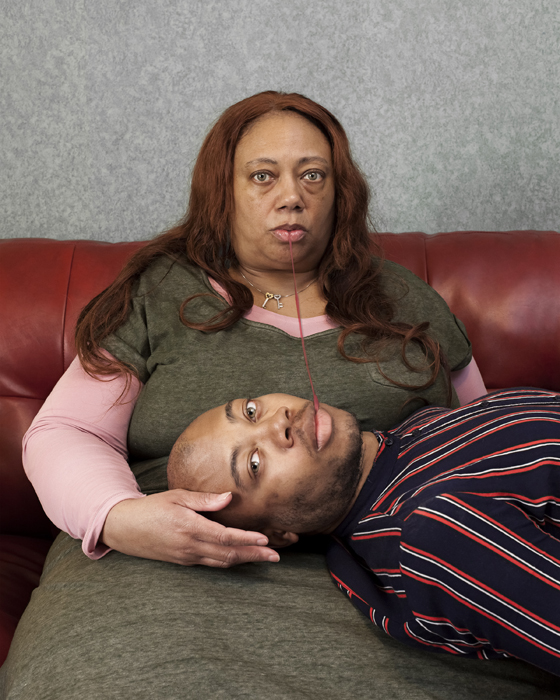In Push (2011), an oil-on-canvas portrait by Titus Kaphar, a working African woman massages the vacant limbs of the excised subject—a curvy figure has been removed from the frame, leaving a white void where a body once lay. Kaphar’s masterful, intentional act of redaction overtly critiques the colonial histories of portraiture, “the gaze,” and relegation of Black subjects to scenes of labor. By removing the sitter who receives the luxury of labor, viewers are forced to focus on the African woman, a worker who would otherwise be ignored.
Kaphar’s painting is one of several evocative contemporary works featured in Permutations: Concepts 1, now on view at the Silber Gallery at Goucher College. The exhibition premieres selections from the private collections of Lisa Gregory and Darryl Atwell, including works by Nina Chanel Abney, Laylah Ali, Jarvis Boyland, Zoë Charlton, Noah Davis, John Edmonds, Derek Fordjour, Jerrell Gibbs, Delita Martin, Naudline Pierre, Tajh Rust, and D’Angelo Lovell Williams.
“For art to inspire, it must be seen,” Gregory and Atwell told me during an interview. “One of our greatest joys is sharing our collection and hopefully spurring further thought in young minds.”
L: Naudline Pierre, “Tread Lightly,” oil on canvas (2017); R: John Edmonds, “Untitled – Hood 9,” archival print (2017)
Permutations has a keen interest in Black figuration and the ways its featured artists explore and usurp presumptions about history and identity. The exhibition also functions as a broader appraisal of Goucher’s archival practices and that of other institutions which have systemically omitted works by women, non-binary folks, and artists of color in favor of those rendered by white-cis-male artists.
“How do we address the shortcomings in collections whose contents largely come to the institution through donation?” asks Alex Ebstein, Director of Exhibitions and Curator, in the catalog statement. Though one exhibition cannot resolve the tenuous history and contemporary decision-making of art institutions, it can trigger dialogue about accountability, inclusive archival practices, and radical reform.
I asked Gregory and Atwell to share some of their wisdom about the act of collecting and the importance of exhibiting diverse works of art.

Jerrell Gibbs, “Different Cloth,” oil on canvas (2019)
Angela N. Carroll: Were you invited to loan works from your collection for the Permutations exhibition or did you suggest the collaboration?
Lisa Gregory and Darryl Atwell: The show was a collaboration. We had the idea to share work, and the gallery/institution had the desire to introduce its community to artists that it may have otherwise not been exposed to. It turns out to be perfectly symbiotic.
The exhibition has a strong focus on figurative contemporary works. What inspired the focus of figuration rather than abstraction?
Within the diaspora, there is continued debate about abstraction vs. figurative work. In our collecting, we certainly pay attention to both forms. However, we realize the significance of imagery; the absence of images of Black people in most hallowed institutions is still stark. We thought this first show needed to highlight the “figure” as a central theme to grasp the viewer’s attention: to help make Black people less invisible.

Zoë Charlton, “Undercover-Yellow,” graphite and acrylic on canvas (2014)
Institutions have struggled with or ignored the responsibility to create more inclusive collections and exhibitions that featured works by post-war and contemporary artists, particularly those from the African diaspora. Do you see yourself and your collection practices as shifting that tradition?
We do hope our actions of patronage show community support as cultural stewards. We also hope to help continue to change the idea of what great art is. In that vein, it’s a statement to the status quo to pay attention to these artists. Institutions that ignore them do so now at their peril. Not only will their collection potentially look incomplete in the future, but they also risk missing out on a new class of art patrons and art enthusiasts.
Do you have any plans to loan works to other institutions, museums, or galleries for other upcoming exhibitions?
Yes, we will continue our efforts to show works. From our small cohort-collecting-crew, we think we can have very stimulating shows and hopefully continue to introduce communities to emerging Black artists.
Do you have any advice for young or emerging collectors?
Advice for new collectors is first to see and read about as much art as you can. Include art in your vacations, dates, etc. Secondly, finding a mentor (i.e., a more experienced collector) can be invaluable in helping you navigate this crazy art world.
L: D’Angelo Williams, “Until We Separate (Mom),” pigment print (2019); R: Delita Martin, “Quilted Angel,” gelatin printing, hand-stitched fabric, and conte (2015)
Permutations: Concepts 1 is on view in Goucher College’s Silber Gallery through December 14.
Featured image: Titus Kaphar, “Push,” oil on canvas (2011)
Images courtesy of Alex Ebstein










